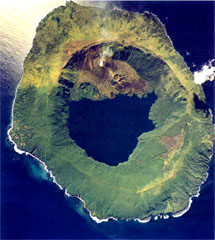Report on Tofua (Tonga) — April 2015
Bulletin of the Global Volcanism Network, vol. 40, no. 4 (April 2015)
Managing Editor: Richard Wunderman.
Tofua (Tonga) Five thermal alerts detected, 28 September-30 June 2015
Please cite this report as:
Global Volcanism Program, 2015. Report on Tofua (Tonga) (Wunderman, R., ed.). Bulletin of the Global Volcanism Network, 40:4. Smithsonian Institution. https://doi.org/10.5479/si.GVP.BGVN201504-243060
Tofua
Tonga
19.75°S, 175.07°W; summit elev. 515 m
All times are local (unless otherwise noted)
Tofua is a remote volcano in Tonga that is not monitored. The primary sources of information about the volcano's activity are from infrequent field visits, ash advisories from the Wellington Volcanic Ash Advisory Centre, and MODIS thermal sensors aboard the Aqua and Terra satellites.
No ash advisories from the Wellington Volcanic Ash Advisory Centre were issued during the reporting period, 28 September 2013-30 June 2015. Since the last report through 27 September 2013 (BGVN 38:07), five thermal alerts were recorded through 30 June 2015 (table 3). Two of those alerts, on 14 and 23 September 2014, were located outside and NW of the caldera rim and therefore were probably not associated with volcanic activity. No thermal alerts were issued between 18 October 2014 and 30 June 2015.
Table 3. Thermal alerts between 28 September 2013 and 30 June 2015. Thermal alerts are derived from data collected by the MODIS thermal sensors aboard the Aqua and Terra satellites and processed by the Hawaii Institute of Geophysics and Planetology using the MODVOLC algorithm. Courtesy of Hawaii Institute of Geophysics and Planetology.
| Date | No. Pixels | Satellite |
| 10 Oct 2013 | 2 | Aqua |
| 27 Jul 2014 | 1 | Aqua |
| 14 Sep 2014 | 1 | Aqua |
| 23 Sep 2014 | 1 | Terra |
| 18 Oct 2014 | 2 | Terra |
Several articles on Tofua's volcanic geology and geochemistry published in the past few years have come to our attention (Caulfield, 2011, 2012, 2015). Caulfield and others (2011, 2012) include helpful aerial and cross-section sketches of the volcano's various geologic features.
References: Caulfield, J. T., Cronin, S.J., Turner, S.P., & Cooper, L.B., 2011, Mafic Plinian volcanism and ignimbrite emplacement at Tofua volcano, Tonga, Bull. Volcanology, v. 73, pp.1259–1277.
Caulfield, J. T., Turner, S. P., Smith, I. E. M., Cooper, L. B., & Jenner, G. A., 2012, Magma evolution in the primitive, intra-oceanic Tonga arc: petrogenesis of basaltic andesites at Tofua volcano. Journal of Petrology, v. 53(6), pp. 1197-1230.
Caulfield, J. T., Blichert-Toft, J., Albarède, F., & Turner, S. P., 2015, Corrigendum to 'Magma Evolution in the Primitive, Intra-oceanic Tonga Arc: Petrogenesis of Basaltic Andesites at Tofua Volcano'and 'Magma Evolution in the Primitive, Intra-oceanic Tonga Arc: Rapid Petrogenesis of Dacites at Fonualei Volcano, Journal of Petrology, v. 56(3), pp. 641-644.
Geological Summary. The low, forested Tofua Island in the central part of the Tonga Islands group is the emergent summit of a large stratovolcano that was seen in eruption by Captain Cook in 1774. The summit contains a 5-km-wide caldera whose walls drop steeply about 500 m. Three post-caldera cones were constructed at the northern end of a cold fresh-water caldera lake, whose surface lies only 30 m above sea level. The easternmost cone has three craters and produced young basaltic-andesite lava flows, some of which traveled into the caldera lake. The largest and northernmost of the cones, Lofia, has a steep-sided crater that is 70 m wide and 120 m deep and has been the source of historical eruptions, first reported in the 18th century. The fumarolically active crater of Lofia has a flat floor formed by a ponded lava flow.
Information Contacts: Hawai'i Institute of Geophysics and Planetology (HIGP), MODVOLC Thermal Alerts System, School of Ocean and Earth Science and Technology (SOEST), Univ. of Hawai'i, 2525 Correa Road, Honolulu, HI 96822, USA (URL: http://modis.higp.hawaii.edu/).

